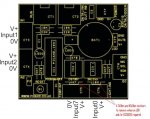Hi All.
1.
I have purchased the AXE110 so i can log 4 analouge channels, but i seems that input 7 is dedicated to the temperature sensor.
Can i just rename the basic code from 'readtemp' to 'readadc' ?
2. How do I spot the 2 resistors I will need to cut off, one 10kOhm pull-down for the 'LDR-input0' and one 4,7kOhm pull-up for the temperature sensor ? (Input 7)
As I will not need pull-up/down for my data-logging mission.
Best regards, Bo Andersen.
1.
I have purchased the AXE110 so i can log 4 analouge channels, but i seems that input 7 is dedicated to the temperature sensor.
Can i just rename the basic code from 'readtemp' to 'readadc' ?
2. How do I spot the 2 resistors I will need to cut off, one 10kOhm pull-down for the 'LDR-input0' and one 4,7kOhm pull-up for the temperature sensor ? (Input 7)
As I will not need pull-up/down for my data-logging mission.
Best regards, Bo Andersen.


